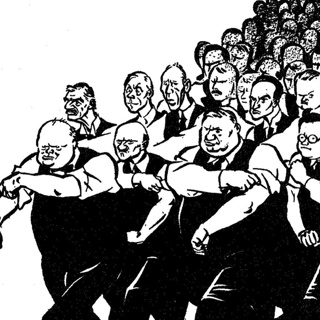
136. Triumph proves transitory
It had all been going so well. The Congress of Berlin had been a huge success, allowing Disraeli (and Salisbury) to bring back peace with honour. Things should have been flowing the Conservatives’ way. But then there were a couple of bad military adventures, launched by over-powerful and out-of-control colonial administrators. Both ended up costing a lot of money and a lot of lives, for little gain. One, the Second Anglo-Afghan War, was even launched from India while a famine that eventually cost 8 million lives was raging and relief budgets were being cut to save money, although funds were being poured into waging war. At the same time, the British economy was doing badly, with a recession and bad harvests. That all added up to a rather bleaker picture for the Conservatives than their successes might have implied. This episode also introduces three people we'll be hearing more about later, and who had significant moments in the 1870s (in one case, the moment was birth, a pretty significant event, without which it’s hard for anyone to make a name for themselves). Illustration: Graveyard at Isandlwana, site of Britain's worst defeat in a colonial war since the American War of Independence. Photo from Zulu Kingdom Travel Guide. Music: Bach Partita #2c by J Bu licensed under an Attribution-NonCommercial-No Derivatives (aka Music Sharing) 3.0 International License.
2 Apr 202314min

135. Peace with honour
We start this episode with a Russian army north of Constantinople ready to invade the city, and a British naval squadron in the waters to its south ready – or at least apparently ready – to resist it. In the end, it was the Russians who blinked. With war avoided, the Berlin Congress of all the European Great Powers met and left Russia with a much reduced list of gains from its war against Turkey, than it had try to secure in the Treaty of San Stefano. Disraeli and Salisbury conducted preliminary negotiations to ensure that they had commitments to the outcome they wanted before even going into the Congress. That allowed Disraeli to proclaim on his return that he had won ‘Peace with Honour’. In his case, that was probably true, which can’t be said of many of the people who’ve used the expression since. The Congress was the major and substantial foreign policy achievement of a premiership which had also contained some earlier symbolic successes, such as the purchase of Suez Canal shares and the granting to Victoria of the title ‘Empress of India’. For now, the only shadow was Disraeli’s own health, that drove him in tiredness from the stressful environment of the Commons to the calmer waters of the Lords. Finally, the episode talks of the appointment of a bookseller as First Lord of the Admiralty, and how that fed into the glorious Gilbert and Sullivan operetta, HMS Pinafore. Illustration: Detail from a publicity poster for Gilbert and Sullivan’s HMS Pinafore. Public domain Music: Bach Partita #2c by J Bu licensed under an Attribution-NonCommercial-No Derivatives (aka Music Sharing) 3.0 International License.
26 Mars 202314min

134. Jingo
Here’s the episode where we learn where the word Jingoism was born. After talking last time about the remarkable achievements on the domestic front of the second Disraeli government with its social reform, this week we start to look at what interested him far more: foreign affairs. And the biggest affair of them all was the ‘Eastern Question’, precipitated by yet another war between Russia and Turkey. That in turn followed on from the massacres carried out by Turkish forces in the Balkans, specifically what came to be known as the ‘Bulgarian atrocities’. Gladstone re-emerged from semi-retirement to denounce those horrors. Disraeli, on the other hand, was far more worried about the behaviour of the Russians and intent on blocking their expansion. As time went on, public opinion seemed to swing increasingly in his direction. “We don't want to fight,” claimed the music hall song, “but by Jingo if we do, we've got the ships, we've got the men, we've got the money too.” In deciding how to confront the Russian threat, Disraeli found himself working increasingly closely with a man with whom he’d previously fallen out badly, Lord Salisbury. And, we’ll see, their collaboration worked. Illustration: HMS Alexandra, flagship of the British Mediterranean fleet in the 1870s, and one of the ironclads that forced the Dardanelles. Public domain.Music: Bach Partita #2c by J Bu licensed under an Attribution-NonCommercial-No Derivatives (aka Music Sharing) 3.0 International License.
19 Mars 202314min

133. Progressive Conservatives
Disraeli’s second government was an administration of progressive conservatism, a strange moment in a general history of the Conservative Party as essentially, well, conservative. Partly that was politically expedient, looking for support among the working class, but partly it was sincere, based on a deep revulsion at the conditions in which most of it lived. Much of the reforming legislation was piloted by Richard Cross, Disraeli’s imaginative, and bold, choice as Home Secretary. It included the conclusion of the long campaign led by many but above all by Lord Shaftesbury, to limit the hours worked by women and children. It also abolished the use of ‘climbing boys’, the use of kids as chimney sweeps. It, astonishingly for a Conservative government, extended union rights, including decriminalising the right to picket. And it even included the introduction of the Plimsoll line on ships, to prevent overloading and the many sailors’ deaths to which it led. On all these reforms, resistance was loud and strong from business interests. And, the final surprise of this time, they were being faced down by a Conservative government. Illustration: Samuel Plimsoll, Lithograph by by Richard Childs, 1874 National Portrait Gallery D42829 Music: Bach Partita #2c by J Bu licensed under an Attribution-NonCommercial-No Derivatives (aka Music Sharing) 3.0 International License.
12 Mars 202314min

132. The pendulum swings
We've reached the point where the political pendulum has at last swung the Conservative way, giving it a working parliamentary majority for the first time in three decades. Despite all his efforts to get that majority in 1874, Disraeli seems to have been surprised by the extent of his success. He took power without a properly worked-out set of policies to apply. In particular, since he was more interested in foreign affairs, he had little in place in the way of a domestic programme. For that he would depend on his ministers, so getting their selection right was a major task. One of the most difficult nuts to crack would be getting Salisbury into his government, if only to stop him sniping from outside. This he pulled off in part thanks to the intervention of the Countess of Derby, though her relationships with Salisbury and other leading figures in the story is worthy of a soap opera. The absence of a good domestic programme left a space open into which the Archbishop of Canterbury was able to insert a nasty piece of Church legislation, in the course of the last ever parliamentary session that would be overwhelmingly devoted to a religious matter. That was in strange contrast with the instincts of Disraeli’s government which, despite being Conservative, were strangely progressive socially. Illustration: the lady with a background worthy of a soap opera, Mary Catherine (née Sackville-West), Marchioness of Salisbury (later Countess of Derby), by Camille Silvy. National Portrait Gallery Ax53033. Music: Bach Partita #2c by J Bu licensed under an Attribution-NonCommercial-No Derivatives (aka Music Sharing) 3.0 International License.
5 Mars 202314min

131. Sea change
A sea change took place at the 1874 British general election. The previous year, Gladstone and his government, exhausted by its searing pace of reform, lost a parliamentary vote on what he saw (and many of his colleagues didn’t) as the essential third leg of his tripod of measures to pacify Ireland, the foundation of a Catholic university in Ireland. They resigned but Disraeli, in a brilliant political move, refused to take his place. So Gladstone had buckle on the armour again and his failing government struggled on for a few months more. Over those months, a scandal hit them and, in the course of reshuffling his ministers, he decided to take on the Chancellorship of the Exchequer himself, a further burden on a man already worn out by his responsibilities. So, when the election was finally called, the Conservatives went in revitalised while the Liberals fought it already half defeated. The result? For the first time in 33 years, the Conservatives won a parliamentary majority and Disraeli could finally form a government with a chance of lasting a while. What’s more, a new party representing Irish interests took a big block of seats too. Far from pacifying Ireland, all Gladstone had done was preside over the appearance of a new organisation speaking out against British rule. And even against his own party. Another episode in the unravelling rule of Britain in Ireland… Illustration: Gladstone, cartoon by Carlo Pellegrini published in Vanity Fair, 6 February 1869 National Portrait Gallery 1978 Music: Bach Partita #2c by J Bu licensed under an Attribution-NonCommercial-No Derivatives (aka Music Sharing) 3.0 International License.
26 Feb 202314min

130. Pacifying Ireland
“My mission is to pacify Ireland,” Gladstone had declared when he took office as Prime Minister. This episode looks briefly at Disraeli’s behaviour as he left power, including the peerage he sought for his wife (rather than for himself). Then we move on to Gladstone’s attempts to secure peace in Ireland, first through disestablishment of the Church of Ireland, then through new legislation concerning Irish land ownership. They involved serious and exhausting battles, though they achieved very little in the way of pacifying Ireland... As the exhaustion of these struggles began to affect the government, and indeed Gladstone, Disraeli found new form and came back to the attack. Notably with one of his best known denunciations of ministers, as a series of dormant volcanoes. The pendulum was swinging back his way. Illustration: William Ewart Gladstone by Sir John Everett Millais, 1879. National Portrait Gallery 3637 Music: Bach Partita #2c by J Bu licensed under an Attribution-NonCommercial-No Derivatives (aka Music Sharing) 3.0 International License.
19 Feb 202314min

129. The Liberals get liberal
The Liberals are back, and they're being liberal. Gladstone followed Disraeli into Downing Street, and led a reforming government. So Disraeli with the Conservatives managed to reach the top of the greasy pole first, but he got only ten months before being kicked out unceremoniously by Gladstone and the Liberal Party. Oddly, though, Gladstone didn't too well personally, losing his parliamentary seat - as he had at the previous election too. He only managed to cling on in parliament by being nominated for another seat at the same time, and winning that one. His government brought in a slew of reforms followed in the military, in education, in trade union law and, as another key step on the road to democracy, in legislation to introduce secret ballots in national and local elections. This was also the time when Germany emerged as a nation, proclaimed as the Second Reich in, of all places, the Hall of Mirrors of Versailles, in defeated and humiliated France. German victory was a warning to the other powers, one that Britain failed to take seriously enough. Meanwhile, trouble was continuing in Ireland. But since pacifying that country was Gladstone’s self-declared mission, we’ve left that to our next episode. Illustration: Anton von Werner, The proclamation of the German Empire in the Hall of Mirrors of Versailles. Painted in 1885, it shows the subjects, including King William I, about to be made emperor, at their 1885 ages rather than as they were when the event took place in 1871. Public Domain. Music: Bach Partita #2c by J Bu licensed under an Attribution-NonCommercial-No Derivatives (aka Music Sharing) 3.0 International License.
12 Feb 202314min





















